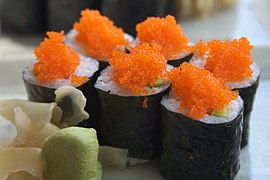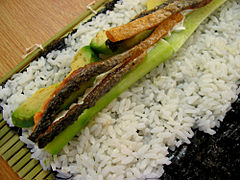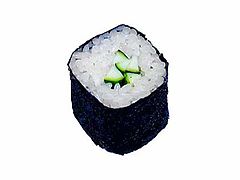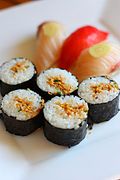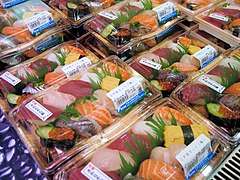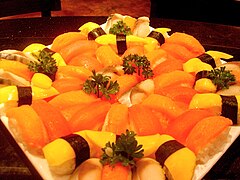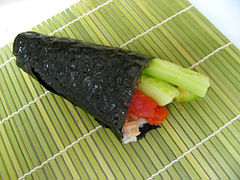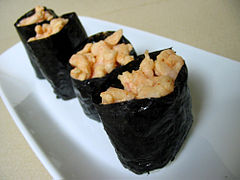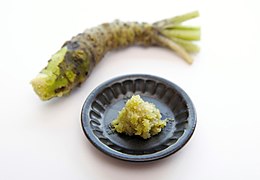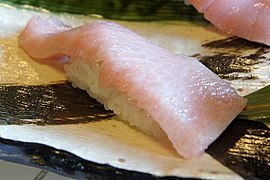Sushi
 Sushi platter | |
| Place of origin | Japan |
|---|---|
| Main ingredients |
|
Sushi(すし, thọ tư, nghệ, trả,pronounced[sɯɕiꜜ]or[sɯꜜɕi])is a Japanese dish of prepared vinegaredrice(Nghệ phạn,sushi-meshi),usually with somesugarandsalt,plus a variety of ingredients(ねた,neta),such asvegetables,and anymeat,but most commonlyseafood(often raw but can be cooked). Styles of sushi and its presentation vary widely, but the one key ingredient is "sushi rice", also referred to asshari(しゃり),orsumeshi(Tạc phạn).[1]
The creator of modern sushi is believed to beHanaya Yohei,who invented nigiri-zushi, a type of sushi most known today, in whichseafoodis placed on hand-pressed vinegared rice, around 1824 in theEdo period(1603–1867). It was the fast food of thechōninclass in the Edo period.[2][3][4]
Sushi is traditionally made with medium-grainwhite rice,though it can be prepared withbrown riceor short-grain rice. It is very often prepared with seafood, such assquid,eel,yellowtail,salmon,tunaorimitation crab meat.Many types of sushi are vegetarian. It is often served withpickled ginger(gari),wasabi,andsoy sauce.Daikon radishorpickled daikon(takuan)are popular garnishes for the dish.
Sushi is sometimes confused withsashimi,a dish that consists of thinly sliced rawfishor occasionallymeat,without sushirice.[5]
History
[edit]
Narezushi
[edit]A dish known asnarezushi(Tuần れ thọ tư, thục thọ tư,"matured fish" ),stored in fermented rice for possibly months at a time, has been cited as one of the early influences for the Japanese practice of applying rice on raw fish. The fish was fermented with rice vinegar, salt, and rice, after which the rice was discarded.[6]Narezushiis also calledhonnare,meaning "fully fermented", as opposed tonamanare,meaning "partially fermented", a type of sushi that appeared in theMuromachi period.[7]
Fermented fish using rice, such asnarezushi,originated inSoutheast Asiawhere it was made to preservefreshwater fish,possibly in theMekong Riverbasin, which is nowLaos,Cambodia,ThailandandVietnam,and in theIrrawaddy Riverbasin, which is nowMyanmar.[7]The first mention of anarezushi-like food is in a Chinese dictionary thought to be from the 4th Century, in this instance referring to salted fish that had been placed in cooked or steamed rice, which caused it to undergo a fermentation process vialactic acid.[8][9]Fermentation methods following similar logic in other Asian rice cultures includeburong isda,balao-balao,andtinapayanof thePhilippines;pekasamofIndonesiaandMalaysia,pla ra(ปลาร้า) ofThailand;sikhae(식해) ofKorea;andMắm bò hócorcá chuaof Vietnam.[9][6][10][11][12]
Thelacto-fermentationof the rice prevents the fish from spoiling. When wet-field rice cultivation was introduced during theYayoi period,lakes and rivers would flood during the rainy season and fish would get caught in the rice paddy fields. Pickling was a way to preserve the excess fish and guarantee food for the following months, andnarezushibecame an important source of protein for Japanese consumers. The termsushiliterally means "sour-tasting", as the overall dish has a sour andumamior savory taste. The term comes from anantiquatedしshiterminal-form conjugation, no longer used in other contexts, of theadjectival verbsui(Toan い,"to be sour" ),[13]resulting in the termsushi(Toan し).[14]Narezushistill exists as a regional specialty, notably asfuna-zushifromShiga Prefecture.[15]
In theYōrō Code(Dưỡng lão luật lệnh,Yōrō-ritsuryō)of 718, the characters for "Nghệ" and "Trả" are written as a tribute to the Japanese imperial court, and although there are various theories as to what exactly this food was, it is possible that it referred tonarezushi.[16]
Namanare
[edit]Until the early 19th century sushi slowly changed and the Japanese cuisine changed as well. The Japanese started eating three meals a day, rice was boiled instead of steamed, and of large importance was the development ofrice vinegar.[17]
During theMuromachi period(1336–1573), the Japanese invented a style of sushi callednamanareornamanari(Sinh thành, なまなれ, なまなり), which means "partially fermented". The fermentation period ofnamanarewas shorter than that of the earliernarezushi,and the rice used for fermentation was also eaten with the fish. In other words, with the invention ofnamanare,sushi changed from a preserved fish food to a food where fish and rice are eaten together. After the appearance ofnamanare,sakeand sake lees were used to shorten fermentation, and vinegar was used in theEdo period.[7]
Hayazushi
[edit]
During theEdo period(1603–1867), a third type of sushi,haya-zushi(Tảo thọ tư, tảo ずし,"fast sushi" ),was developed.Haya-zushidiffered from earlier sushi in that instead of lactic fermentation of rice, vinegar, a fermented food, was mixed with rice to give it a sour taste so that it could be eaten at the same time as the fish. Previously, sushi had evolved with a focus on shortening the fermentation period, but with the invention ofhaya-zushi,which is simply mixed with vinegar, the fermentation process was eliminated and sushi became a fast food. Many types of sushi known in the world today, such aschirashizushi(Tán らし thọ tư,"scattered sushi" ),inarizushi(Đạo hà thọ tư,"Inarisushi "),makizushi(Quyển thọ tư,"rolled sushi" ),andnigirizushi(Ác り thọ tư,"hand-pressed sushi" ),were invented during this period, and they are a type ofhaya-zushi.Each region utilizes local flavors to produce a variety of sushi that has been passed down for many generations. A 1689 cookbook describeshaya-zushi,and a 1728 cookbook describes pouring vinegar overhako-zushi(Tương ずし,"box sushi" )(square sushi made by filling a wooden frame with rice).[7]
Nigirizushi
[edit]Today's style ofnigirizushi(Ác り thọ tư,"hand-pressed sushi" ),consisting of an oblong mound of rice with a slice of fish draped over it, became popular inEdo(contemporary Tokyo) in the 1820s or 1830s. One common story of the origin ofnigirizushiis of the chefHanaya Yohei(1799–1858), who invented or perfected the technique in 1824 at his shop inRyōgoku.[15]Thenigirizushiof this period was somewhat different from modernnigirizushi.The sushi rice of this period was about three times the size of today'snigirizushi.The amount of vinegar used was half that of today's sushi, and the type of vinegar developed during this period, calledaka-su(Xích tạc,"red vinegar" ),was made by fermenting sake lees. They also used slightly more salt than in modern times instead of sugar. Seafood served over rice was prepared in a variety of ways. This red vinegar was developed by Nakano Matazaemon ( trung dã hựu tá vệ môn ), who is the founder ofMizkan,a company that still develops and sells vinegar and other seasonings today.[7]
The dish was originally termedEdomae zushias it used freshly caught fish from theEdo-mae(Edo orTokyo Bay); the termEdomae nigirizushiis still used today as a by-word for quality sushi, regardless of its ingredients' origins.[18][19]
Conveyor belt sushi
[edit]
In 1958, Yoshiaki Shiraishi opened the firstconveyor belt sushirestaurant(Hồi 転 thọ tư,kaiten-zushi)named "GenrokuZushi "inHigashi-Osaka.In conveyor belt sushi restaurants, conveyor belts installed along tables and counters in the restaurant transport plates of sushi to customers. Generally, the bill is based on the number of plates, with different colored plates representing the price of the sushi.[20][21][22]
When Genroku Sushi opened a restaurant at theJapan World Exposition, Osaka, 1970,it won an award at the expo, and conveyor belt sushi restaurants became known throughout Japan. In 1973, an automatic tea dispenser was developed, which is now used in conveyor belt sushi restaurants today. When the patent for conveyor belt sushi restaurants expired, a chain of conveyor belt sushi restaurants was established, spreading conveyor belt sushi throughout Japan and further popularizing and lowering the price of sushi. By 2021, the conveyor belt sushi market had grown to 700 billion yen and spread outside Japan.[20][21][22]
Sushi in English
[edit]The earliest written mention ofsushiin English described in theOxford English Dictionaryis in an 1893 book,A Japanese Interior,where it mentions sushi as "a roll of cold rice with fish, sea-weed, or some other flavoring".[23][24]There is an earlier mention of sushi inJames Hepburn's Japanese–English dictionary from 1873,[25]and an 1879 article on Japanese cookery in the journalNotes and Queries.[26]Despite common misconception among English speakers, sushi does not mean "raw seafood."[27]
Types
[edit]
The common ingredient in all types ofsushiis vinegaredsushirice. Fillings, toppings, condiments, and preparation vary widely.[28]
Due torendakuconsonant mutation,sushiis pronounced withzuinstead ofsuwhen a prefix is attached, as innigirizushi.
Chirashizushi
[edit]
Chirashizushi(ちらし thọ tư,"scattered sushi", also referred to asbarazushi)serves the rice in a bowl and tops it with a variety of raw fish and vegetable garnishes. It is popular because it is filling, fast, and easy to make.[29]It is eaten annually onHinamatsuriin March andKodomonohiin May.
- Edomae chirashizushi(Edo-style scattered sushi) is served with uncooked ingredients in an artful arrangement.
- Gomokuzushi(Kansai-style sushi) consists of cooked or uncooked ingredients mixed in the body of rice.
- Sake-zushi(Kyushu-style sushi) uses rice wine over vinegar in preparing the rice and is topped with shrimp, sea bream, octopus, shiitake mushrooms, bamboo shoots, and shredded omelette.
Inarizushi
[edit]
Inarizushi(Đạo hà thọ tư)is a pouch offried tofutypically filled with sushi rice alone. According to Shinto lore,inarizushiis named after the godInari.Foxes, messengers of Inari, are believed to have a fondness for friedtofu,and aninarizushiroll has pointed corners that resemble fox ears.[30]
Regional variations include pouches made of a thin omelette (Bạch sa thọ tư,fukusa-zushi,orTrà cân thọ tư,chakin-zushi) instead of tofu. It should not be confused withinari maki,a roll filled with flavored fried tofu.
Cone sushi is a variant ofinarizushioriginating inHawaiithat may includegreen beans,carrots,gobo,orpokealong with rice, wrapped in a triangularabura-agepiece. It is often sold inokazu-ya(Japanesedelis) and as a component ofbentoboxes.[31][32][33][34]
Makizushi
[edit]Makizushi(Quyển き thọ tư,"rolled sushi" ),norimaki(Hải đài quyển き,"noriroll ", used generically for other dishes as well)ormakimono(Quyển vật,"variety of rolls" )is a cylindrical piece formed with the help of a mat known as amakisu(Quyển き liêm).Makizushiis generally wrapped in nori (seaweed) but is occasionally wrapped in a thinomelette,soy paper, cucumber, orshiso(perilla) leaves.Makizushiis often cut into six or eight pieces, constituting a single roll order. Short-grain white rice is usually used, although short-grain brown rice, likeolive oilon nori, is now becoming more widespread among the health-conscious. Rarely, sweet rice is mixed inmakizushirice.
Nowadays, the rice inmakizushican be many kinds of black rice, boiled rice, and cereals. Besides the common ingredients listed above, some varieties may include cheese, spicy cookedsquid,yakiniku,kamaboko,lunch meat,sausage, bacon or spicytuna.The nori may be brushed with sesame oil or sprinkled with sesame seeds. In a variation, sliced pieces ofmakizushimay be lightly fried with egg coating.
Below are some common types ofmakizushi,but many other kinds exist.
- Futomaki(Thái quyển,"thick, large, or fat rolls" )is a large, cylindrical style of sushi, usually with nori on the outside.[35]A typicalfutomakiisfive to six centimeters (2 to2+1⁄2in) in diameter.[36]They are often made with two, three, or more fillings that are chosen for their complementary tastes and colors.Futomakiare often vegetarian, and may use strips of cucumber,kampyōgourd,takenoko(bamboo shoots), orlotus root.Strips oftamagoyakiomelette, tiny fishroe,chopped tuna, andoborowhitefishflakes are typical non-vegetarian fillings.[35]Traditionally, the vinegared rice is lightly seasoned with salt and sugar. Popular proteins are fish cakes, imitation crab meat, egg, tuna, or shrimp. Vegetables usually include cucumber, lettuce, andtakuan(Trạch am,pickled radish).
- Tamago makizushi(Ngọc tử quyển き thọ tư)ismakizushiis wrapped in a thin omelet.
- Tempura makizushi(Thiên ぷら quyển き thọ tư)oragezushi(Dương げ thọ tư ロール)is a fried version of the dish.
- During the evening of the festival ofSetsubun(Tiết phân),it is traditional in theKansai regionto eat a particular kind offutomakiin its uncut cylindrical form, calledehōmaki(Huệ phương quyển,"lucky direction roll" ).[37]By 2000 the custom had spread to all of Japan.[38]Ehōmakiis a roll composed of seven ingredients considered to be lucky. The typical ingredients includekanpyō,egg, eel, andshiitake.Ehōmakioften include other ingredients too. People usually eat theehōmakiwhile facing the direction considered to be auspicious that year.[39]
- Hosomaki(Tế quyển,"thin rolls" )is a type of small cylindrical sushi with nori on the outside. A typicalhosomakihas a diameter of about 2.5 centimeters (1 in).[36]They generally contain only one filling, often tuna, cucumber,kanpyō,nattō,umeboshipaste, and squid withshiso(Japanese herb).
- Kappamaki( hà đồng quyển ) is a kind ofhosomakifilled with cucumber. It is named after the Japanese legendary water imp, fond of cucumbers, called thekappa.Traditionally,kappamakiis consumed to clear the palate between eating raw fish and other kinds of food so that the flavors of the fish are distinct from the tastes of other foods.
- Tekkamaki(Thiết hỏa quyển)is a kind ofhosomakifilled with raw tuna. Although it is believed that the wordtekka,meaning "red hot iron", alludes to the color of the tuna flesh or salmon flesh, it actually originated as a quick snack to eat in gambling dens calledtekkaba(Thiết hỏa tràng),much like the origins of thesandwich.[40][41]
- Negitoromaki(ねぎとろ quyển)is a kind ofhosomakifilled withnegitoro,also known asscallion(negi) and chopped tuna (toro). Fatty tuna is often used in this style.
- Tsunamayomaki(ツナマヨ quyển)is a kind ofhosomakifilled with canned tuna tossed withmayonnaise.
- Temaki(Thủ quyển,"hand roll" )is a large cone-shaped style of sushi with nori on the outside and the ingredients spilling out the wide end. A typicaltemakiis about 10 centimeters (4 in) long and is eaten with the fingers because it is too awkward to pick it up withchopsticks.For optimal taste and texture,temakimust be eaten quickly after being made because the nori cone soon absorbs moisture from the filling and loses its crispness, making it somewhat difficult to bite through. For this reason, the nori in pre-made or take-out temaki is sealed in plastic film, which is removed immediately before eating.[42]
-
Makizushitopped withtobiko
-
Makizushiin preparation
-
Futomaki
-
Kappamaki
-
Nattōmaki
-
Tekkamaki
-
Ehōmaki
Modernnarezushi
[edit]
Narezushi(Thục れ thọ tư,"matured sushi" )is a traditional form of fermented sushi. Skinned and gutted fish are stuffed with salt, placed in a wooden barrel, doused with salt again, then weighed down with a heavytsukemonoishi(pickling stone). As days pass, water seeps out and is removed. After six months, this sushi can be eaten, remaining edible for another six months or more.[43]
The most famous variety ofnarezushiare the ones offered as a specialtydish of Shiga Prefecture,[44]particularly thefuna-zushimade from fish of thecrucian carp genus,the authentic version of which calls for the use ofnigorobuna,a particular locally differentiated variety ofwild goldfishendemictoLake Biwa.[45]
Nigirizushi
[edit]

Nigirizushi(Ác り thọ tư,"hand-pressed sushi" )consists of an oblong mound of sushi rice that a chef typically presses between the palms of the hands to form an oval-shaped ball and a topping (theneta) draped over the ball. It is usually served with a bit ofwasabi;toppings are typically fish such as salmon, tuna, or other seafood. Certain toppings are typically bound to the rice with a thin strip of nori, most commonlyoctopus(tako), freshwatereel(unagi), sea eel (anago),squid(ika), and sweet egg (tamago).
Gunkanmaki(Quân hạm quyển,"warship roll" )is a special type ofnigirizushi:an oval, hand-formed clump of sushi rice that has a strip of nori wrapped around its perimeter to form a vessel that is filled with some soft, loose or fine-chopped ingredient that requires the confinement of nori such asroe,nattō,oysters,uni(sea urchinroe), sweetcorn with mayonnaise, scallops, and quail eggs.Gunkan-makiwas invented at theGinzaKyubey restaurant in 1941; its invention significantly expanded the repertoire of soft toppings used in sushi.[46][47]
Temarizushi(Thủ まり thọ tư,"ball sushi" )is a style of sushi made by pressing rice and fish into a ball-shaped form by hand using a plastic wrap.
Oshizushi
[edit]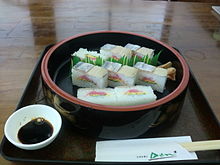
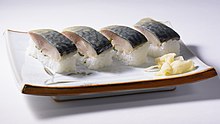
Oshizushi(Áp し thọ tư,"pressed sushi" ),also known ashako-zushi(Tương thọ tư,"box sushi" ),is a pressed sushi from theKansai region,a favorite and specialty ofOsaka.A block-shaped piece is formed using a wooden mold, called anoshibako.The chef lines the bottom of theoshibakowith the toppings, covers them with sushi rice, and then presses the mold's lid to create a compact, rectilinear block. The block is removed from the mold and then cut into bite-sized pieces. Particularly famous isbattera(バッテラ,pressed mackerel sushi)orsaba zushi(Chinh thọ tư).[48]Inoshizushi,all the ingredients are either cooked or cured, and raw fish is never used.[49]The namebatterameans "small boat" in Portuguese (bateira), as the sushi molds resembled small boats.[50]
Oshizushiwrapped inpersimmonleaves, a specialty ofNara,is known askakinohazushi(Thị の diệp thọ tư).
Searedoshizushi,oraburi oshizushi(Chích り áp し thọ tư),is a popular variety invented inVancouver, BCin 2008.[51][52][53]This involves using abutane torchto sear the sushi, which may contain ingredients such asmayonnaise,various sauces,jalapeños,andavocadoin addition to typical sushi ingredients such as salmon and mackerel. The variety has since spread to other cities, such as Toronto.[54]
Western-style sushi
[edit]
The increasing popularity of sushi worldwide has resulted in variations typically found in theWestern worldbut rarely in Japan. A notable exception to this is the use of salmon. The Japanese have eaten salmon since prehistory; however, caught salmon in nature often containsparasitesand must be cooked orcuredfor its lean meat to be edible. On the other side of the world, in the 1960s and 1970s, Norwegian entrepreneurs started experimenting withaquaculturefarming. The big breakthrough was when they figured out how to raise salmon in net pens in the sea. Being farm-raised, theAtlantic salmonreportedly showed advantages over thePacific salmon,such as no parasites, easy animal capture, and could be grown with higher fat content. With government subsidies and improved techniques, they were so successful in raising fatty and parasite-free salmon they ended up with a surplus. Norway has a small population and limited market; therefore, they looked to other countries to export their salmon. The first Norwegian salmon was imported into Japan in 1980, accepted conventionally, for grilling, not for sushi. Salmon had already been consumed in North America as an ingredient in sushi as early as the 1970s.[56][57][58]Salmon sushi did not become widely accepted in Japan until a successful marketing partnership in the late 1980s between Bjorn Eirik Olsen, a Norwegian businessman tasked with helping the Norwegian salmon industry glut, and the Japanese food supplierNichirei.[59][60][55]
Other sushi creations to suit the Western palate were initially fueled by the invention of theCalifornia roll,anorimakiwhich presently almost always usesimitation crab(the original recipe calls for real cooked crab), along with avocado and cucumber.[61]A wide variety of popular rolls (norimakianduramaki) have evolved since. 'Norway roll' is another variant ofuramakizushifilled withtamago(omelette), imitation crab and cucumber, rolled withshisoleaf andnori,topped with slices of Norwegian salmon, garnished with lemon and mayonnaise.[62]
Uramaki
[edit]
Uramaki(Lí quyển,"inside-out roll" )is a medium-sized cylindrical style of sushi with two or more fillings and was developed as a result of the creation of the California roll, as a method originally meant to hide the nori.Uramakidiffers from othermakimonobecause the rice is on the outside and the nori inside. The filling is surrounded by nori, then a layer of rice, and optionally an outer coating of some other ingredients such as roe or toastedsesame seeds.It can be made with different fillings, such as tuna, crab meat, avocado, mayonnaise, cucumber, or carrots.
Examples of variations include therainbow roll(an inside-out topped with thinly slicedmaguro, hamachi, ebi, sakeand avocado) and the caterpillar roll (an inside-out topped with thinly sliced avocado). Also commonly found is the "rock and roll" (an inside-out roll with barbecued freshwater eel and avocado with toasted sesame seeds on the outside).
In Japan,uramakiis an uncommon type ofmakimono;because sushi is traditionally eaten by hand in Japan, the outer layer of rice can be quite difficult to handle with fingers.[63]
In Braziluramakiand other sushi pieces commonly include cream cheese in their recipe. Although unheard of in Japanese sushi, this is the most common sushi ingredient used in Brazil.Temakialso often contains a large amount of cream cheese and is extremely popular in restaurants.[64]
American-stylemakizushi
[edit]
Multiple-filling rolls inspired byfutomakiare a more popular type of sushi within the United States and come in variations that take their names from their places of origin. Other rolls may include a variety of ingredients, including choppedscallops,spicy tuna,beef or chickenteriyakiroll,okra,and assortedvegetablessuch as cucumber and avocado, and the tempura roll, where shrimp tempura is inside the roll or the entire roll is battered and fried tempura-style. In the Southern United States, many sushi restaurants prepare rolls usingcrawfish.Sometimes, rolls are made withbrown riceorblack rice,known as forbidden rice, which appear in Japanese cuisine as well.
PerFood and Drug Administrationregulations, raw fish served in the United States must be frozen before serving to kill parasites.[65]
Since rolls are often made to order, it is not unusual for the customer to specify the exact ingredients desired (e.g., salmon roll, cucumber roll, avocado roll, tuna roll, shrimp or tunatempuraroll, etc.). Though the menu names of dishes often vary by restaurant, some examples include the following:
| Image | Sushi roll name | Definition |
|---|---|---|
| Alaskan roll | A variant of theCalifornia rollwith smoked salmon on the inside or layered on the outside.[66] | |
| Boston roll | AnuramakiCalifornia rollwithpoachedshrimpinstead ofimitation crab.[67] | |

|
British Columbia roll | A roll containing grilled or barbecued salmon skin, cucumber, and sweet sauce, sometimes withroe.Also sometimes referred to as salmon skin rolls outside ofBritish Columbia,Canada.[68] |

|
California roll | A roll consisting ofavocado,kani kama(imitation crab/crab stick) (also can contain real crab in "premium" varieties),cucumber,andtobiko,often made asuramaki(with rice on the outside, nori on the inside).[69] |

|
Dragon roll | A rolling containing fillings such as shrimp tempura, cucumber, and unagi, and is wrapped distinctively with avocado on the outside. Also commonly called a "Caterpillar Roll", its avocado exterior resembles the scales of a dragon.[70] |

|
Dynamite roll | A roll includingyellowtail(hamachi) or prawn tempura, and fillings such as bean sprouts, carrots, avocado, cucumber, chili, spicy mayonnaise, and roe.[71] |
| Hawaiian roll | A roll containingshōyutuna (canned),tamago,kanpyō,kamaboko,and the distinctive red and greenhana ebi(shrimp powder).[72] | |
| Mango roll | A roll including fillings such as avocado, crab meat, tempura shrimp, and mango slices, and topped off with a creamy mango paste.[73] | |
| Michigan roll | A roll including fillings such as spicy tuna, smelt roe, spicy sauce, avocado, and sushi rice. It is a variation on a spicy tuna roll.[74] | |
| New Mexico roll | A roll originating inNew Mexico;includesNew Mexico green chile(sometimes tempura-fried), teriyaki sauce, and rice.[75][76]Sometimes simply referred to as a "green chile (tempura) roll" within the state.[77][78] | |

|
Philadelphia roll | A roll consisting of raw or smoked salmon andcream cheese(the name refers toPhiladelphia cream cheese), with cucumber, avocado, and/or scallion.[79]Functionally synonymous with Japanese bagel (JB) roll and Seattle roll.[80] |

|
Rainbow roll | A Californiauramakiroll with multiple types of fish (commonly yellowtail, tuna, salmon, snapper, white fish, eel, etc.) and avocado wrapped around it.[81] |

|
Spicy tuna roll | A roll including raw tuna mixed with sriracha mayonnaise. |

|
Spider roll | A roll including friedsoft-shell craband other fillings such as cucumber, avocado, daikon sprouts or lettuce, roe, and sometimes spicy mayonnaise.[82] |

|
Sushi burrito | A large, customizable roll offered in several "sushi burrito" restaurants in the United States.[83] |
Canada
[edit]
Many of the styles seen in the United States are also seen in Canada and their own. Doshi (a portmanteau ofdonutandsushi) is a donut-shaped rice ball on a deep-fried crab or imitation crab cake topped with sushi ingredients.[84]Makipoutineis similar tomakizushiin style except it is topped with cheese curds and gravy and contains duckconfit,more cheese curds, and sweet potato tempura.[85]Sushi cake is made of crab meat, avocado, shiitake mushroom, salmon, spicy tuna, and tobiko and served on sushi rice, then torched with spicy mayonnaise, barbecue sauce, and balsamic reduction, and dotted with caper and garlic chips.[86]Sushi pizzais deep-fried rice or crab/imitation crab cake topped with mayonnaise and various sushi ingredients.[87]
Mexico and the Western United States
[edit]Sinaloan sushioriginated inSinaloa, Mexicoand has been available in the Western United States since 2013.[88]
Similar dishes in Asia
[edit]South Korea
[edit]Gimbap,similar tomakizushi,is an internationally popular convenience food of Korean origin.[89]It consists ofgim(the Korean version ofnori) rolled around rice seasoned with sesame oil, instead of vinegar, and a variety of ingredients such as vegetables, likedanmuji,and meat, likebulgogi.[90]
Ingredients
[edit]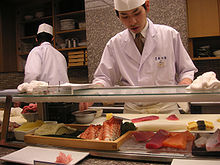
All sushi has a base of specially prepared rice, complemented with other ingredients. Traditional Japanese sushi consists of rice flavored with vinegar sauce and various raw or cooked ingredients.
Sushi-meshi
[edit]Sushi-meshi(Nghệ phạn)(also known assu-meshi(Tạc phạn),shari(Xá lợi),orgohan(ご phạn)) is a preparation of white, short-grained,Japanese ricemixed with a dressing consisting ofrice vinegar,sugar,salt,and occasionallykombuandsake.It must be cooled to room temperature before being used for a sushi filling, or it will get too sticky while seasoned. Traditionally, it is mixed with ahangiri(a round, flat-bottom wooden tub or barrel) and ashamoji(a wooden paddle).
Sushi rice is prepared with short-grain Japanese rice, which has a consistency that differs from long-grain strains such as those from India, Sri Lanka, Bangladesh, Thailand, and Vietnam. The essential quality is its stickiness or glutinousness, although the type of rice used for sushi differs fromglutinous rice.Freshly harvested rice (shinmai) typically contains too much water and requires extra time to drain the rice cooker after washing. In somefusion cuisinerestaurants, short-grainbrown riceandwild riceare also used.
There are regional variations in sushi rice, and individual chefs have their methods. Most of the variations are in the rice vinegar dressing: theKantō region(or East Japan) version of the dressing commonly uses more salt; inKansai region(or West Japan), the dressing has more sugar.
Nori
[edit]
The dark green seaweed wrappers used inmakimonoare callednori(Hải đài).Nori is a type ofalgaetraditionally cultivated in the harbors of Japan. Originally, algae was scraped from dock pilings, rolled out into thin, edible sheets, and dried in the sun, similar to makingrice paper.[91]Today, the commercial product is farmed, processed, toasted, packaged, and sold in sheets.
The size of a nori sheet influences the size ofmakimono.A full-size sheet producesfutomaki,and a half produceshosomakiandtemaki.To producegunkanand some othermakimono,an appropriately-sized piece of nori is cut from a whole sheet.
Nori by itself is an edible snack and is available with salt or flavored with teriyaki sauce. The flavored variety, however, tends to be of lesser quality and is not suitable for sushi.
When makingfukusazushi,a paper-thin omelet may replace a sheet of nori as the wrapping. The omelet is traditionally made on a rectangular omelet pan, known as amakiyakinabe,and used to form the pouch for the rice and fillings.[92]
Gu
[edit]


The ingredients used inside sushi are calledguand are, typically, varieties of fish.[93]For culinary, sanitary, and aesthetic reasons, the minimum quality and freshness of fish to be eaten raw must be superior to that of fish that is to be cooked. Sushi chefs are trained to recognize important attributes, including smell, color, firmness, and freedom from parasites that may go undetected in a commercial inspection. Commonly used fish aretuna(maguro, shiro-maguro),Japanese amberjack,yellowtail (hamachi),snapper(kurodai),mackerel(saba), andsalmon(sake). The most valued sushi ingredient istoro,the fatty cut of the fish.[94]This comes in a variety ofōtoro(often from the bluefin species of tuna) andchūtoro,meaning "middle toro", implying that it is halfway into the fattiness betweentoroand the regular cut.Aburistyle refers to nigiri sushi, where the fish is partially grilled (topside) and partially raw. Most nigiri sushi will have completely raw toppings, calledneta.[93]
Other seafoods such assquid(ika),eel(anagoandunagi),pike conger(hamo),octopus(tako),shrimp(ebiandamaebi),clam(mirugai,aoyagiandakagai), fishroe(ikura,masago,kazunokoandtobiko),sea urchin(uni),crab(kani), and various kinds of shellfish (abalone, prawn, scallop) are the most popular seafoods in sushi.Oystersare less common, as the taste is thought to not go well with the rice.Kani kama,or imitation crab stick, is commonly substituted for real crab, most notably in California rolls.[95]
Pickleddaikonradish (takuan) inshinko maki,pickled vegetables (tsukemono), fermented soybeans (nattō) innattō maki,avocado,cucumberinkappamaki,asparagus,[96]yam,pickledume(umeboshi),gourd(kanpyō),burdock(gobo), and sweet corn (sometimes mixed with mayonnaise) are plant products used in sushi.
Tofu,eggs(in the form of slightly sweet, layered omelette calledtamagoyaki), and raw quail eggs (as agunkan-makitopping) are also common.
Condiments
[edit]Sushi is commonly eaten with condiments. Sushi may be dipped inshōyu(soy sauce), and is usually flavored withwasabi,a piquant paste made from the grated stem of theWasabia japonicaplant.Japanese-style mayonnaiseis a common condiment in Japan on salmon, pork, and other sushi cuts.
The traditional grating tool for wasabi is a sharkskin grater orsamegawa oroshi.An imitation wasabi (seiyo-wasabi), made fromhorseradish,mustard powder, and green dye, is common. It is found at lower-endkaiten-zushirestaurants, inbento boxsushi, and at most restaurants outside Japan. If manufactured in Japan, it may be labelled "Japanese Horseradish".[97]The spicy compound in both true and imitation wasabi isallyl isothiocyanate,which has well-knownanti-microbialproperties. However, true wasabi may contain some other antimicrobials as well.[98]
Gari(sweet, pickledginger) is eaten in between sushi courses to both cleanse the palate and aid in digestion. In Japan,green tea(ocha) is invariably served together with sushi. Better sushi restaurants often use a distinctive premium tea known asmecha.In sushi vocabulary, green tea is known asagari.
Sushi may be garnished withgobo,grateddaikon,thinly-sliced vegetables, carrots, radishes, and cucumbers that have been shaped to look like flowers, real flowers, or seaweed salad.
When closely arranged on a tray, different pieces are often separated by green strips calledbaranorkiri-zasa(Thiết り thế).These dividers prevent the flavors of neighboring pieces of sushi from mixing and help to achieve an attractive presentation. Originally, these were cut leaves from theAspidistra elatior(Diệp lan,haran)andSasa veitchii(Hùng thế,kuma-zasa)plants, respectively. Using actual leaves had the added benefit of releasing antimicrobialphytoncideswhen cut, thereby extending the limited shelf life of the sushi.[99]
Sushi bento boxes are a staple of Japanese supermarkets and convenience stores. As these stores began rising in prominence in the 1960s, the labor-intensive cut leaves were increasingly replaced with green plastic to lower costs. This coincided with the increased prevalence of refrigeration, which extended sushi's shelf life without the need for cut leaves. Today plastic strips are commonly used in sushi bento boxes and, to a lesser degree, in sushi presentations found in sushi bars and restaurants. In store-sold or to-go packages of sushi, the plastic leaf strips are often used to prevent the rolls from coming into early or unwanted contact with the ginger and wasabi included with the dish.[100]
Nutrition
[edit]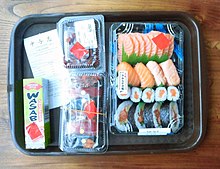
The main ingredients of traditional Japanese sushi, raw fish and rice, are naturally low in fat and high inprotein,carbohydrates(the rice only),vitamins,and minerals, as aregariandnori.Other vegetables wrapped in sushi[101]may also offer nutrients.[medical citation needed]
Health risks
[edit]Potential chemical and biological hazards in sushi include environmental contaminants,pathogens,and toxins.
Large marineapex predatorssuch astuna(especiallybluefin) can harbor high levels ofmethylmercury,one of many toxins ofmarine pollution.Frequent or significantly large consumption of methylmercury can lead to developmental defects when consumed by certain higher-risk groups, including women who are pregnant or may become pregnant, nursing mothers, and young children.[102]A 2021 study in Catalonia, Spain reported that the estimated exposure to methylmercury in sushi consumption by adolescents exceeded the tolerable daily intake.[103]
A 2011 article reported approximately 18 million people infected with fish-borneflukesworldwide.[104]Such an infection can be dangerous for expecting mothers due to the health risks that medical interventions or treatment measures may pose on the developing fetus.[104]Parasitic infections can have a wide range of health impacts, including bowel obstruction, anemia, liver disease, and more.[104]These illnesses' impact can pose health concerns for the expecting mother and baby.[104]
Sashimior other types of sushi containing raw fish present a risk of infection by three main types ofparasites:
- Clonorchis sinensis,aflukewhich can causeclonorchiasis[105]
- Anisakis,aroundwormwhich can causeanisakiasis[106]
- Diphyllobothrium,atapewormwhich can causediphyllobothriasis[107]
For these reasons, EU regulations forbid using raw fish that had not previously been frozen. It must be frozen at temperatures below −20 °C (−4 °F) in all product parts for no less than 24 hours.[108]Fish for sushi may beflash frozenon fishing boats and by suppliers to temperatures as low as −60 °C (−76 °F).[109]Super-freezing destroys parasites, and also prevents oxidation of the blood in tuna flesh that causes discoloration at temperatures above −20 °C (−4 °F).[110]
Calls for stricter analysis and regulation of seafood include improved product description. A 2021 DNA study in Italy found 30%–40% of fish species in sushi incorrectly described.[111]
Some forms of sushi, notably those containing thefugupufferfish and some kinds of shellfish, can cause severe poisoning if not prepared properly. Fugu consumption, in particular, can be fatal. Fugu fish has a lethal dose oftetrodotoxinin its internal organs and, by law in many countries, must be prepared by a licensed fugu chef who has passed the prefectural examination in Japan.[112]Licensing involves a written test, a fish-identification test, and a practical test that involves preparing the fugu and separating out the poisonous organs; only about 35 percent of applicants pass.[113]
Sustainable sushi
[edit]Sustainable sushi is made from fished or farmed sources that can be maintained or whose future production does not significantly jeopardize the ecosystems from which it is acquired.
Presentation
[edit]


Traditionally, sushi is served on minimalist Japanese-style, geometric, mono- or duo-tone wood or lacquer plates, keeping with this cuisine's aesthetic qualities.[citation needed]
Many sushi restaurants offer fixed-price sets selected by the chef from the catch of the day. These are often graded as tùng trúc mai(shō-chiku-bai),shō/matsu(Tùng,pine),chiku/take(Trúc,bamboo),andbai/ume(Mai,plum),withmatsuthe most expensive andumethe cheapest.[citation needed]Sushi restaurants will often have private booth dining, where guests are asked to remove their shoes, leaving them outside the room; However, most sushi bars offer diners a casual experience with an open dining room concept.

Sushi may be servedkaiten zushi(sushi train) style: color-coded plates of sushi are placed on a conveyor belt from which diners pick as they please. After finishing, the bill is tallied by counting how many plates of each color have been taken. Newerkaiten zushirestaurants usebarcodesorRFIDtags embedded in the dishes to manage elapsed time after the item was prepared.[114]
There is a practice callednyotaimoriwhich entails serving sushi on the naked body of a woman.[115][116][117]
Glossary
[edit]Some specialized or slang terms are used in the sushi culture. Most of these terms are used only in sushi bars.
- Agari:lit. 'Rise up',refers togreen tea.Ocha(お trà)in usual Japanese.
- Gari:Sweet, pickled and slicedginger,orsushi ginger.Shōga(Sinh khương)in standard Japanese.
- Gyoku:"Jewel". Sweet, cube-shaped omelette. Noãn thiêu, ngọc tử thiêu(Tamagoyaki)in standard Japanese.
- Murasaki:"Violet" or "purple" (color). Soy sauce.Shōyu(醤 du)in standard Japanese.
- Neta:Toppings on nigiri or fillings inmakimono.A reversal of the standard Japanesetane(Chủng).
- Oaiso:"Compliment". Bill or check.Oaisomay be used in not only sushi bars but alsoizakaya.[118][119]Okanjō(お khám định)orchekku(チェック)in standard Japanese.
- Otemoto:Chopsticks.Otemotomeans the nearest thing to the customer seated.Hashi(Trứ)orohashiin standard Japanese.
- Sabi:Contracted form of wasabi(Sơn quỳ),also known as Japanesehorseradish.
- Shari:Vinegarriceor rice. It may originally be from theSanskritzaali(शालि) meaning rice, orŚarīra.Gohan(ご phạn)) ormeshi(Phạn)in standard Japanese.
- Tsume:Sweet thick sauce mainly made of soy sauce.Nitsume(Chử cật め)in standard Japanese.[120]
Etiquette
[edit]Unlike sashimi, which is almost always eaten with chopsticks,nigirizushiis traditionally eaten with the fingers, even in formal settings.[121]Although it is commonly served on a small platter with a side dish for dipping, sushi can also be served in abento,a box with small compartments that hold the various dishes of the meal.
Soy sauce is the usual condiment, and sushi is normally served with a small sauce dish or a compartment in the bento. Traditional etiquette suggests that the sushi is turned over so that only the topping is dipped to flavor it; the rice—which has already been seasoned with rice wine vinegar, sugar, salt, mirin, and kombu—would otherwise absorb too much soy sauce and would fall apart.[122]
Traditionally, the sushi chef will add an appropriate amount of wasabi to the sushi while preparing it, and the diner should not add more.[122]However, today, wasabi is more a matter of personal taste, and even restaurants in Japan may serve wasabi on the side for customers to use at their discretion, even when there is wasabi already in the dish.[123]
Utensils used in making sushi
[edit]| Utensil | Definition |
|---|---|
| Fukin | Kitchen cloth |
| Hangiri | Rice barrel |
| Hocho | Kitchen knives |
| Makisu | Bamboo rolling mat |
| Ryoribashiorsaibashi | Cooking chopsticks |
| Shamoji | Wooden rice paddle |
| Makiyakinabe | Rectangular omelette pan |
| Oshizushihako | A mold used to makeoshizushi |
Gallery
[edit]-
Toro nigiri(Vị とろ ác り,fatty tuna belly)
-
Salmon roll(Quyển き khuê)
-
Kakinoha(Thị の diệp thọ tư,persimmonleaf)sushi
-
Chakin-zushi(Trà cân thọ tư),wrapped in thin omelette
-
Sushi plate(Thịnh り hợp わせ)
-
Ikura gunkan-maki(イクラ quân hạm quyển き)
-
Sasa(Thế thọ tư,bamboo leaf)sushi
-
Unagi(Man thọ tư,teriyaki-roasted freshwater eel)sushi
-
Nigirizushifor sale at a supermarket in Tokyo
-
Assorted sushi(Thịnh り hợp わせ)
-
Assorted Western sushi(Thịnh り hợp わせ)
-
Western spicy tuna hand roll(スパイシーツナロール)
-
Western spicy shrimp roll(スパイシー hải lão ロール)
-
Gari(ginger)
-
Wasabi
-
Tamagosushi
-
Otoro sushi ( vị đại トロ thọ tư )
See also
[edit]- Gimbap,Korean variant ofmakizushi
- Customs and etiquette in Japanese dining
- List of sushi and sashimi ingredients
- List of sushi restaurants
- Nyotaimori,sushi presented on nude female body
- Sashimi bōchō,Japanese knife to slice raw fish and seafood
- Spam musubi,Hawaiian variant ofnigirizushi
- Sushi machine
References
[edit]- ^"Sushi – How-To".FineCooking.May 1, 1998.Archivedfrom the original on November 4, 2019.RetrievedNovember 4,2019.
- ^"The Mysteries of Sushi – Part 2: Fast Food".Toyo Keizai.May 23, 2015. Archived fromthe originalon September 9, 2017.
- ^"When Sushi Became a New Fast Food in Edo".Nippon.com. December 22, 2020. Archived fromthe originalon January 18, 2021.
- ^"Sushi".Nihonbashi. Archived fromthe originalon December 28, 2021.
- ^"Sashimi vs Sushi – Difference and Comparison | Diffen".www.diffen.com.Archivedfrom the original on June 5, 2019.RetrievedJune 5,2019.
- ^abLee, Cherl-Ho; Steinkraus, Keith H; Reilly, P.J. Alan (1993).Fish fermentation technology.Tokyo: United Nation University Press.OCLC395550059.Archivedfrom the original on January 13, 2021.RetrievedJune 17,2021.
- ^abcdeHirofumi Akano."The evolution of sushi and the power of vinegar".Japan Science and Technology Agency.pp. 201, 202. Archived fromthe originalon February 14, 2023.RetrievedApril 4,2023.
- ^Mouritsen, O. G. (2009).SUSHI food for the eye, the body & the soul(2nd ed.). Boston:Springer.p. 15.Bibcode:2009sfeb.book.....M.doi:10.1007/978-1-4419-0618-2.ISBN978-1-4419-0617-5.
- ^abSanchez, Priscilla C. (2008)."Lactic-Acid-Fermented Fish and Fishery Products".Philippine Fermented Foods: Principles and Technology.University of the Philippines Press. p. 264.ISBN9789715425544.
- ^Hill, Amelia (October 8, 2007)."Chopsticks at dawn for a sushi showdown".The Guardian.London.Archivedfrom the original on December 17, 2007.RetrievedSeptember 25,2011.
- ^Guerra, M.I. (1994). "Studies on tinapayan, an indigenous fish ferment in Central Mindanao (Philippines)".AGRIS.1(2): 364–365.
- ^"Unveiling the origins of sushi: a journey through Vietnam".Tuoi Tre News.May 4, 2024.RetrievedMay 10,2024.
- ^1988, quốc ngữ đại từ điển ( tân trang bản ) (Kokugo Dai Jiten, Revised Edition) (in Japanese), Tōkyō: Shogakukan
- ^Kouji Itou; Shinsuke Kobayashi; Tooru Ooizumi; Yoshiaki Akahane (2006). "Changes of proximate composition and extractive components in narezushi, a fermented mackerel product, during processing".Fisheries Science.72(6): 1269–1276.Bibcode:2006FisSc..72.1269I.doi:10.1111/j.1444-2906.2006.01285.x.S2CID24004124.
- ^abBestor, Theodore C.(July 13, 2004).Tsukiji: The Fish Market at the Center of the World.University of California Press. p. 141.ISBN9780520923584.
- ^Ác りずし thủy まりは giang hộ っ tử のホットドッグスタンド(in Japanese).Nikkei, Inc.June 9, 2018. Archived fromthe originalon October 28, 2020.RetrievedApril 4,2023.
- ^Mpritzen, Ole G. (2009).Sushi: Food for the Eye, the Body and the Soul.Springer Science-Business Media. p. 15.
- ^Lowry, Dave (2010).The Connoisseur's Guide to Sushi.ReadHowYouWant.com. p. xvii.ISBN978-1458764140.Archivedfrom the original on June 17, 2021.RetrievedNovember 1,2020.
A nugget of rice was seasoned with vinegar and topped by a sliver of seafood fresh from the bay that was only a few blocks away. That is why a synonym for nigiri sushi is Edomae sushi: Edomae is "in front of Edo," i.e., the bay.
- ^Mouritsen, Ole G. (2009).Sushi: Food for the Eye, the Body and the Soul.Springer. p. 17.ISBN978-1441906182.Archivedfrom the original on June 17, 2021.RetrievedNovember 1,2020.
Edomae-zushi or nigiri-zushi? Nigiri-zushi is also known as Edomae-zushi. Edomae refers to the small bay in Edo in front of the old palace that stood on the same site as the present-day imperial precinct in Tokyo. Fresh fish and shellfish caught in the bay were used locally to make sushi, known as Edomae-zushi. It has, however, been many years since these waters have been a source of seafood. Now the expression Edomae-zushi is employed as a synonym for high-quality nigiri-zushi.
- ^abMagnier, Mark (September 2, 2001)."Yoshiaki Shiraishi; Founded Conveyor Belt Sushi Industry".Los Angeles Times.RetrievedFebruary 4,2016.
- ^abHồi 転 thọ tư の lịch sử は bán thế kỷ siêu! Hồi 転 thọ tư チェーン, それぞれの đặc trưng は?(in Japanese). Sushi walker. February 26, 2023. Archived fromthe originalon February 14, 2024.RetrievedFebruary 14,2024.
- ^abHồi 転 thọ tư の lịch sử(in Japanese). Genroku Zushi. Archived fromthe originalon December 1, 2023.RetrievedFebruary 14,2024.
- ^"Sushi,"Oxford English Dictionary,Second edition, 1989; online version December 2011. Accessed 23 December 2011.
- ^Bacon, Alice Mabel (1893).A Japanese interior.Houghton, Mifflin and Company. p.271.
p. 271: "Sushi, a roll of cold rice with fish, sea-weed, or some other flavoring" p. 181: "While we were waiting for my lord and my lady to appear, domestics served us with tea and sushi or rice sandwiches, and the year-old baby was brought in and exhibited." p. 180: "All the sushi that I had been unable to eat were sent out to mykuruma,neatly done in white paper. "
- ^James Curtis Hepburn,Japanese–English and English–Japanese dictionary,Publisher: Randolph, 1873, 536 pages (page 262)
- ^W. H. Patterson,Japanese Cookery,"Notes and Queries," Publisher: Oxford University Press, 1879. (p.263Archived2016-02-02 at theWayback Machine)
- ^Mikkelson, Barbara."Sushi Definition".Snopes.RetrievedJune 19,2024.
- ^Kawasumi, Ken (2001).The Encyclopedia of Sushi Rolls.Graph-Sha.ISBN978-4-88996-076-1.
- ^Adimando, Stacy (March 18, 2019)."Chirashi is Sushi for the Rest of Us".Saveur.RetrievedOctober 24,2022.
- ^Smyers, Karen Ann.The Fox and the Jewel: Shared and Private Meanings in Contemporary Japanese Inari Worship(1999), Honolulu: University of Hawaii Press, p. 96.
- ^Ann Kondo Corum,Ethnic FoodsofHawaii(2000).Bess Press:p. 54.
- ^Betty Shimabukuro, "Yama's Fish Market offers more than fishArchived2012-05-13 at theWayback Machine(March 20, 2002).Honolulu Star-Bulletin.
- ^Joan Namkoong,Go Home, Cook Rice: A Guide to Buying and Cooking the Fresh Foods of Hawaii(2001). Ness Press: p. 8.
- ^Joan Namkoong,Food Lover's Guide to Honolulu(2006), Bess Press, p. 37.
- ^abŌmae, Kinjirō; Tachibana, Yuzuru (1988).The book of sushi(1st paperback ed.). Tokyo: Kōdansha International. p. 70.ISBN9780870118661.OCLC18925025.
- ^abStrada, Judi; Moreno, Mineko Takane (2004).Sushi for dummies.John Wiley & Sons. p. 106.ISBN978-0-7645-4465-1.Archivedfrom the original on August 19, 2020.RetrievedJanuary 9,2019.
Sliced sushi rolls are traditionally made in three different sizes, or diameters: thin 1-inch rolls (hoso-maki); medium 11⁄2-inch rolls (chu-maki); and thick 2 to2+1⁄2-inch rolls (futo-maki). "
- ^"Setsubun [ tiết phân ]".Heisei Nippon seikatsu benrichō [ bình thành ニッポン sinh hoạt tiện lợi trướng ](in Japanese). Tokyo: Jiyū Kokuminsha. 2012. Archived fromthe originalon August 25, 2007.RetrievedMay 26,2012.
- ^"Ehō-maki".Dijitaru daijisen(in Japanese). Tokyo: Shogakukan. 2012. Archived fromthe originalon August 25, 2007.RetrievedMay 26,2012.
- ^"Setsubun Ehomaki, Mame-maki and Grilled Sardine".Kyoto Foodie. February 5, 2009.Archivedfrom the original on August 7, 2014.RetrievedJanuary 22,2015.
- ^Andy Bellin (March 2005)."Poker Night in Napa".Food & Wine.Archivedfrom the original on April 6, 2012.RetrievedJune 28,2007.
- ^Ryuichi Yoshii,"Tuna rolls (Tekkamaki)"Archived2016-05-13 at theWayback Machine,Sushi,p. 48 (1999),Tuttle Publishing,ISBN962-593-460-X.
- ^"Packaging For Temaki Sushi".Gpe.dk.Archivedfrom the original on April 25, 2012.RetrievedNovember 7,2012.
- ^Hosking, Richard (1997).A Dictionary of Japanese Food: Ingredients & Culture.Tuttle Publishing. p. 222.ISBN978-0-8048-2042-4.Archivedfrom the original on August 18, 2020.RetrievedDecember 20,2015.
- ^Lee, Cherl-Ho; Steinkraus, Keith H.; Reilly, P. J. Alan, eds. (1993)."Comparison of Fermented Foods of the East and West".Fish Fermentation Technology.United Nations University Press.p. 17.ISBN9788970530031.OCLC29195449.Archivedfrom the original on August 19, 2020.RetrievedMarch 16,2018.
In Japan, the prototypical form remains mostly around Lake Biwa.
- ^Hosking, Richard (1998),"From Lake and Sea. Goldfish and Mantis Shrimp Sushi",Fish: Food from the Waters,Oxford Symposium, pp. 160–161,ISBN978-0-9073-2589-5,archivedfrom the original on January 10, 2021,retrievedMarch 16,2018
- ^Chad Hershler (May 2005)."Sushi Then and Now".The Walrus.Archived fromthe originalon January 14, 2010.
- ^(ja)Quân カン quyển の do lai,お thọ し đại từ điển > お thọ し dụng ngữ tập,Tiểu tăng thọ しチェーン.
- ^Ashkenazi, Michael; Jacob, Jeanne (2000).The essence of Japanese cuisine: an essay on food and culture.University of Pennsylvania Press. p. 231.ISBN978-0-8122-3566-1.Archivedfrom the original on June 17, 2021.RetrievedOctober 16,2020.
Called saba zushi or battera, after the Portuguese term for "small boat," which the mold resembles.
- ^"Osaka Style Boxed Sushi".Sushi Encyclopedia.Archivedfrom the original on January 16, 2008.
- ^"Battera | Our Regional Cuisines: MAFF".www.maff.go.jp.RetrievedMay 10,2024.
- ^"The origin of Vancouver's deep love for aburi sushi".The Georgia Straight. October 3, 2018.RetrievedMay 29,2024.
- ^"Chef's Table: Seigo Nakamura".NUVO Magazine.RetrievedMay 29,2024.
- ^"8 places to enjoy oshi sushi in Vancouver".The Daily Hive. November 30, 2016.RetrievedMay 29,2024.
- ^"The best aburi sushi in Toronto".Taste Toronto.RetrievedMay 29,2024.
- ^abJiang, Jess (September 18, 2015)."How the Desperate Norwegian Salmon Industry Created a Sushi Staple".Planet Money(blog/podcast).All Things Considered.NPR.Archivedfrom the original on April 24, 2019.RetrievedSeptember 19,2015.
- ^"Episode 651: The Salmon Taboo".NPR.org.Archivedfrom the original on April 17, 2021.RetrievedApril 17,2021.
- ^"How The Desperate Norwegian Salmon Industry Created A Sushi Staple".NPR.org.Archivedfrom the original on April 24, 2019.RetrievedApril 17,2021.
- ^Matsui, Akira (June 1, 2005)."Salmon Exploitation in Jomon Archaeology from a Wetlands Point of View".Journal of Wetland Archaeology.5(1): 49–63.Bibcode:2005JWetA...5...49M.doi:10.1179/jwa.2005.5.1.49.ISSN1473-2971.S2CID140720425.Archivedfrom the original on June 17, 2021.RetrievedApril 17,2021.
- ^Sollesnes, Oeystein (March 10, 2018)."The Norwegian campaign behind Japan's love of salmon sushi".The Japan Times.Archivedfrom the original on January 9, 2019.RetrievedJanuary 9,2019.
- ^Norway Exports (April 8, 2011)."Norway's Introduction of Salmon Sushi to Japan".Nortrade. Archived fromthe originalon January 28, 2017.RetrievedSeptember 19,2015.
- ^Hsin-I Feng, Cindy (February 29, 2012)."The Tale of Sushi: History and Regulations".Comprehensive Reviews in Food Science and Food Safety.11(2): 205–220.doi:10.1111/j.1541-4337.2011.00180.x.ISSN1541-4337.
- ^"Norway Roll of Umegaoka Sushi No Midori Sohonten Shibuya".Archivedfrom the original on August 6, 2016.RetrievedMay 9,2016.
- ^"Sushi Pioneers".SushiMasters.Archived fromthe originalon April 11, 2013.RetrievedJuly 26,2008.
- ^"Tradição X modernidade na comida japonesa | O TEMPO".www.otempo.com.br.Archivedfrom the original on June 17, 2021.RetrievedJune 17,2021.
- ^Julia Moskin (April 8, 2004)."Sushi Fresh From the Deep... the Deep Freeze".The New York Times.Archivedfrom the original on January 6, 2014.RetrievedDecember 23,2013.
Most would be even more surprised to learn that if the sushi has not been frozen, it is illegal to serve it in the United States. Food and Drug Administration regulations stipulate that fish to be eaten raw – whether as sushi, sashimi, seviche, or tartare – must be frozen first to kill parasites.
- ^"Alaska Roll".Sushi Sama. Archived fromthe originalon 18 December 2013.Retrieved11 December2013.
- ^"Boston Roll Recipe".Sushi Encyclopedia. Archived fromthe originalon October 9, 2014.RetrievedOctober 15,2014.
- ^"What is a BC Roll?".The Sushi Index.Archivedfrom the original on December 11, 2014.RetrievedDecember 11,2013.
- ^"California Roll".Sushi Sama. Archived fromthe originalon 18 December 2013.Retrieved11 December2013.
- ^"Dragon Roll Recipe - Sushi Roll Recipes - Sushi Encyclopedia".June 29, 2013. Archived fromthe originalon June 29, 2013.RetrievedFebruary 26,2024.
- ^"Dynamite Roll Recipe".Japanese Sushi Recipes.Archivedfrom the original on July 13, 2013.RetrievedDecember 11,2013.
- ^Frisch, Eleanor."Japanese and Western Types of Sushi".Food Service Warehouse.Archivedfrom the original on November 15, 2013.RetrievedDecember 11,2013.
- ^De Laurentiis, Giada."Crab, Avocado and Mango Roll".Food Network.Archivedfrom the original on December 19, 2013.RetrievedDecember 11,2013.
- ^"Michigan Roll Recipe".The Sushi Encyclopedia.Archivedfrom the original on January 17, 2014.RetrievedDecember 11,2013.
- ^Romero, David (July 13, 2015)."Green chile prominently featured in sushi roll".KRQE.Archivedfrom the original on May 6, 2016.RetrievedMay 16,2016.
- ^Garduño, Gil (October 29, 2011)."I Love Sushi – Albuquerque, New Mexico".Gil's Thrilling (And Filling) Blog.Archivedfrom the original on June 10, 2016.RetrievedMay 16,2016.
- ^"Sushi order form".Japanese Kitchen Albuquerque.Archivedfrom the original on February 1, 2016.RetrievedMay 16,2016.
- ^"Sushi order form".Nagomi Restaurant ABQ.Archivedfrom the original on May 2, 2016.RetrievedMay 16,2016.
- ^"Philadelphia Roll Recipe".Sushi Encyclopedia.Archivedfrom the original on October 28, 2016.RetrievedDecember 11,2013.
- ^"Spicy Seattle Tuna Rolls".Bon Appetit. July 12, 2011.Archivedfrom the original on March 7, 2014.RetrievedDecember 11,2013.
- ^"Rainbow Roll Recipe".Sushi Encyclopedia. Archived fromthe originalon June 27, 2013.RetrievedDecember 11,2013.
- ^Moonen, Rick."Spider Roll".Food Network.Archivedfrom the original on November 17, 2013.RetrievedDecember 11,2013.
- ^Kearns, Landess (June 19, 2015)."Sushi Burritos Prove You Really Can Have It All".Huffington Post.Archivedfrom the original on June 27, 2017.RetrievedMay 14,2017.
- ^Peyton, Gabby (March 16, 2017)."10 questionable things Canada has done to sushi".DailyHIve.RetrievedNovember 3,2021.
- ^Staff, DH Montreal (March 2, 2017)."You have to try this insane Montreal sushi dish".DailyHIve.RetrievedNovember 3,2021.
- ^William-Ross, Lindsay (March 10, 2017)."Where to have your Sushi Cake...and eat it, too".DailyHIve.RetrievedNovember 3,2021.
- ^Chowhound (July 11, 2008)."Sushi Pizza- California specialty?! – General Discussion – Sushi".Chowhound.RetrievedNovember 3,2021.
- ^Bill Esparza (August 1, 2013),"Oh No, There Goes Tokyo Roll—Sinaloa Style Sushi Invades Los Angeles",Los Angeles Magazine
- ^Alexander, Stian (January 21, 2016)."UK's new favourite takeaway has been revealed – and it's not what you'd think".Daily Mirror.Archivedfrom the original on September 26, 2018.RetrievedFebruary 26,2017.
- ^Cho, Joy (January 3, 2021)."Kimbap: Colorful Korean rolls fit for a picnic".Salon.RetrievedJuly 30,2021.
- ^Shimbo, Hiroko (November 8, 2000).The Japanese Kitchen: 250 Recipes in a Traditional Spirit.Harvard Common Press. p. 128.ISBN9781558321779.Archivedfrom the original on June 17, 2021.RetrievedOctober 16,2020.
Unlike wakame, kombu, and hijiki, which are sold in the form of individual leaves, nori is sold as a sheet made from small, soft, dark brown algae, which have been cultivated in bays and lagoons since the middle of the Edo Era (1600 to 1868). The technique of drying the collected algae on wooden frames was borrowed from the famous Japanese paper-making industry.
- ^Pallett, Steven (2004).Simply sushi.Hinkler Books. p. 289.ISBN9781741219722.Archivedfrom the original on June 17, 2021.RetrievedOctober 16,2020.
- ^abLowry, Dave (2005).The Connoisseur's Guide to Sushi: Everything You Need to Know about Sushi Varieties and Accompaniments, Etiquette and Dining Tips, and More.Harvard Common Press.ISBN9781558323070.Archivedfrom the original on June 17, 2021.RetrievedOctober 16,2020.
- ^Smith, Andrew F. (August 8, 2012).American Tuna: The Rise and Fall of an Improbable Food.University of California Press.p.95.ISBN9780520261846.-Archived url,live status.
- ^Orwig, Rob Ludacer, Jessica."Here's what imitation crab meat is really made of".Business Insider.Archivedfrom the original on June 5, 2019.RetrievedJune 5,2019.
{{cite web}}:CS1 maint: multiple names: authors list (link) - ^Sakagami, Nick (June 4, 2019).Sushi Master: An expert guide to sourcing, making and enjoying sushi at home.Quarry Books. p. 87.ISBN9781631596735.Archivedfrom the original on June 17, 2021.RetrievedOctober 16,2020.
- ^Shimbo, Hiroko (2000).The Japanese Kitchen.Harvard Common Press.ISBN978-1-55832-176-2.
- ^Shin, I. S.; Masuda H.; Naohide K. (August 2004). "Bactericidal activity of wasabi (Wasabia japonica) againstHelicobacter pylori".International Journal of Food Microbiology.94(3): 255–61.doi:10.1016/S0168-1605(03)00297-6.PMID15246236.
- ^Gordenker, Alice (January 15, 2008)."Bento grass".The Japan Times Online.ISSN0447-5763.Archivedfrom the original on December 10, 2015.RetrievedDecember 8,2015.
- ^"Culinary Curiosities: That plastic leaf in sushi".CNN. June 21, 2010.Archivedfrom the original on September 26, 2013.RetrievedSeptember 22,2013.
- ^"Sushi Soiree: An Exquisite Fusion of Flavors and Elegance".RetrievedJuly 19,2023.
- ^"Methylmercury: What You Need to Know About Mercury in Fish and Shellfish".Food and Drug Administration.March 1, 2004.Archivedfrom the original on March 17, 2013.RetrievedSeptember 18,2012.
- ^González, N; Correig, E; Marmelo, I; Marques, A; la Cour, R; Sloth, JJ; Nadal, M; Marquès, M; Domingo, JL (July 2021)."Dietary exposure to potentially toxic elements through sushi consumption in Catalonia, Spain".Food and Chemical Toxicology.153:112285.doi:10.1016/j.fct.2021.112285.PMID34023460.S2CID235168607.
- ^abcdJones, J.L.; Anderson, B.; Schulkin, J.; Parise, M. E.; Eberhard, M. L. (March 1, 2011)."Sushi in Pregnancy, Parasitic Diseases – Obstetrician Survey".Zoonoses and Public Health.58(2): 119–125.doi:10.1111/j.1863-2378.2009.01310.x.ISSN1863-2378.PMID20042060.S2CID38590733.Archivedfrom the original on November 6, 2020.RetrievedSeptember 13,2019.
- ^"Clonorchis sinensis – Material Safety Data Sheets (MSDS)".Public Health Agency of Canada.February 18, 2011.Archivedfrom the original on September 14, 2012.RetrievedSeptember 18,2012.
- ^"Parasites – Anisakiasis".Centers for Disease Control and Prevention.November 2, 2010.Archivedfrom the original on September 25, 2012.RetrievedSeptember 18,2012.
- ^Dugdale, DC (August 24, 2011)."Fish tapeworm".MedlinePlus.Archivedfrom the original on July 4, 2016.RetrievedSeptember 18,2012.
- ^European Parliament (April 30, 2004)."Regulation (EC) No 853/2004 of The European Parliament and of the Council of 29 April 2004 laying down specific hygiene rules for on the hygiene of foodstuffs"(PDF).Official Journal of the European Union.139(55): 133.Archivedfrom the original on April 20, 2012.RetrievedJuly 9,2010.
- ^Issenberg, Sasha (2008).The sushi economy: globalization and the making of a modern delicacy.New York: Gotham.ISBN978-1592403639.
- ^Macfarlane, Alex."The Truth About Sushi Fish".Everything Sushi Blog Interview.Archivedfrom the original on April 24, 2013.RetrievedDecember 3,2012.[self-published source]
- ^Pappalardo, AM; Raffa, A; Calogero, GS; Ferrito, V (April 2, 2021)."Geographic Pattern of Sushi Product Misdescription in Italy-A Crosstalk between Citizen Science and DNA Barcoding".Foods.10(4): 756.doi:10.3390/foods10040756.PMC8066630.PMID33918119.
- ^Warin, Rosemary H.; Steventon, Glyn B.; Mitchell, Steve C. (2007).Molecules of death.Imperial College Press. p. 390.ISBN978-1-86094-814-5.Archivedfrom the original on June 17, 2021.RetrievedOctober 16,2020.
- ^"One Man's Fugu Is Another's Poison".The New York Times.November 29, 1981.Archivedfrom the original on January 25, 2012.RetrievedFebruary 26,2011.
- ^"System and method for identification and tracking of food items"(PDF).U.S.Patent Office.Archived(PDF)from the original on February 23, 2019.RetrievedFebruary 23,2019.
- ^Bindel, Julie (February 12, 2010)."'I am about to eat sushi off a naked woman's body'".The Guardian.Archivedfrom the original on July 21, 2020.RetrievedAugust 20,2020.
- ^Danovich, Tove (October 23, 2017)."Is Naked Sushi All About the Nigiri or the Nudity?".VICE.Archivedfrom the original on July 17, 2020.RetrievedAugust 20,2020.
- ^Lin, Eddie (April 18, 2007)."Selling the Sizzle Even Though It's Sushi".The New York Times.Archivedfrom the original on November 9, 2020.RetrievedAugust 20,2020.
- ^(in Japanese)Osushiyasan no arukikata お thọ tư ốc さんの bộ き phươngArchived2012-02-29 at theWayback Machine,Retrieved February 2012.
- ^(in Japanese)'Ojisan, oaiso' tsuihō undō “おじさん, おあいそ” truy phóng vận độngArchived2012-05-09 at theWayback Machine,Retrieved February 2012.
- ^"Japanese Meaning of chử cật める, chử つめる, につめる, nitsumeru".Nihongo Master.Archivedfrom the original on February 4, 2020.RetrievedFebruary 4,2020.
- ^Issenberg, Sasha.The Sushi Economy.Gotham Books: 2007
- ^abHoney, Kim (March 18, 2009)."Are you sushi savvy?".Toronto Star.Archivedfrom the original on March 23, 2009.RetrievedNovember 9,2009.
- ^Lowry, Dave (2005).The Connoisseur's Guide to Sushi.Harvard Common Press.p.273.ISBN978-1-55832-307-0.
Further reading
[edit]- Joro Ono,Masuhiro Yamamoto (2014).Nghệ すきやばし thứ lang: JIRO GASTRONOMY(in Japanese).Shogakukan.ISBN978-4093883856.
- Joro Ono, Masuhiro Yamamoto (2016).Tượng すきやばし thứ lang: JIRO PHILOSOPHY(in Japanese). Shogakukan.ISBN978-4093884976.
- Mitshuhiro Araki,Chieko Asazuma (2004).Giang hộ tiền “Ác り”(in Japanese).Kobunsha.ISBN978-4334032319.

